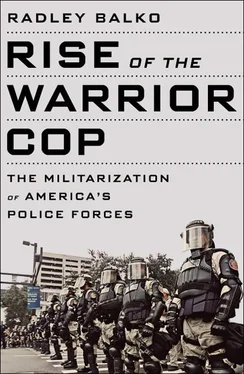Prior to these rulings, as previously noted, there were still plenty of forced-entry raids into private residences in the name of the drug war. There had already been a number of wrong-door raids and a handful of resulting fatalities. But there were still some checks in place to prevent violent raids from becoming an everyday occurrence and to induce drug cops to work carefully and avoid shortcuts. The Exclusionary Rule was the biggest and most important of these checks. If police didn’t follow the proper procedures before breaking into a house, they risked losing any evidence they might find and wasting the time and effort they’d spent conducting the investigation. It was a significant disincentive—and the Court’s 1983 and 1984 decisions cleaved much of it away.

BECAUSE 1984 WAS AN ELECTION YEAR, IT WOULD NEED TO have an omnibus crime bill of its own. Polls showed that crime was the most pressing domestic issue with the public, so everyone running for reelection needed something to tout on the campaign trail. At this point, there wasn’t any real debate about crime policy. It was really only about which party could come up with the most creative ways to empower cops and prosecutors, strip suspects of their rights, and show they were more committed to the battle than their opponents were. The most significant provision in the newest crime bill again dealt with asset forfeiture. The new proposal was to let law enforcement agencies involved with federal drug investigations share in any asset forfeiture proceeds that the case might produce. Previously, forfeiture revenues went toward general operations. Under the new law, the Justice Department would set up a fund with the cash and auction proceeds from its investigations. After the lead federal agency took its cut, any state or local police agencies that had helped out would also get a share.
The measure was considered uncontroversial at the time, but it is difficult to overstate the effect it would have on drug policing over the next thirty years. With drug investigations now a potential source of revenue for police departments, everything would change.
The law’s impact was immediate. After it passed, for example, the CAMP raids and those like them in other parts of the country were no longer just about putting on a good show and terrorizing the counterculture. Now the raids could generate revenue for all of the police agencies involved. The DEA’s Ruzzamenti was rather frank about it in an interview with Ray Raphael for his 1985 book on the CAMP program, Cash Crop . “The biggest focus of what we’re doing is going to be on land seizures,” Ruzzamenti said. “Anybody who is growing marijuana on their land, we’re going to take their land. It’s as simple as that. It’s done civilly through the federal system. Basically, people have to prove that they weren’t involved and didn’t know about it. Just the act of having marijuana grown on your land is enough to tie it up; then you have to turn around and prove you’re innocent. It reverses the burden of proof.” 15
Some people in northern California owned thousands of acres of land, much of it densely forested. Growers were also known to set up operations on someone else’s land, without the owner’s permission. If the feds started a forfeiture process, the owner was then in the difficult position of having to prove his innocence. Even then, federal prosecutors could argue that he should have been more vigilant about policing his property for pot plants. Some landowners faced the loss of hundreds of acres of property over a few dozen marijuana plants grown in an area the size of a backyard garden. Because it was much easier to win land through civil forfeiture than to win a conviction in criminal court, federal prosecutors often offered to drop the criminal charges if the landowners agreed to hand their property over to the federal government.
Those sorts of offers exposed just how fraudulent the government’s justification for its terror tactics really were. Allegedly, these pot growers were the dregs of humanity, greedily poisoning America’s children with their sinister harvest. They were dangerous enough that the government had to send virtual armies to occupy entire towns, buzz homes and chase children with helicopters, set up roadblocks to search cars at gunpoint, and strip suspects and innocents alike of their Fourth Amendment rights. These growers were that dangerous. However, if they were willing to hand over their land, the government was more than happy to let them go free.
Because of the new forfeiture law, police agencies now had a strong incentive to “find” a connection between valuable property and drug activity, even if there was none. They now had an incentive to conduct drug busts inside homes when the suspects could just as easily—and more safely—have been apprehended outside the house. They now had a strong financial incentive to make drug policing a higher priority and to devote more personnel to drug investigations than to investigating other crimes. Closing a rape or murder case didn’t come with a potential kickback to the police department. Knocking off a mid- or low-level drug dealer did. Most perversely of all, the promise of a financial reward actually provided drug cops with an incentive to wait until drugs had already been sold to move in with searches and arrests. A suspect flush with pot or cocaine didn’t offer much forfeiture potential. If they waited to bust him until he’d sold most or all of his supply, the police department got to keep the cash. Subsequent media and academic investigations would bear this out, finding examples of police waiting to bust stash houses until most of their supply had been sold, or of being far more likely to pull over suspected drug-running vehicles in the lanes leading out from large metropolitan areas (when they were likely to be full of cash) than the lanes leading in (when they were more likely to be filled with drugs).
Over the next twenty years, many states would attempt to correct these incentive problems by requiring that any money earned from drug forfeitures be given to a general fund or to a schools fund instead of going back to the police. But under a provision in the federal law called equitable sharing (also known as adoption ), all that a state or local police agency looking at a potentially lucrative forfeiture case needed to do was call up the DEA to assist in their investigation. Even cursory involvement from a federal agency made the investigation federal, and subject to federal law. Whatever laws the state legislature tried to pass to curb abuses no longer applied. The federal government then took its cut and gave the rest of the proceeds (sometimes as much as 80 percent) back to the local police agency.
These forfeiture policies would soon help fund the explosion of SWAT teams across the country—forging yet another tie between the escalating drug war and hypermilitarized policing.
IT WAS AN UNUSUALLY COLD FEBRUARY NIGHT IN LOS ANGELES, and Daryl Gates was riding shotgun in his newest toy, a modified armored personnel carrier. Gates had been asking the city for armored vehicles for years, and he had always been denied. Though Los Angeles officials had fully embraced the city’s SWAT teams by the mid-1980s, they were still squeamish about letting city police use military equipment. But in preparing security for the 1984 Olympics, Gates was able to obtain a couple of old APCs from the Department of Energy. In a former life, they had been used to guard nuclear power plants. After the Olympics, Gates had the vehicles painted blue, emblazoned with a city seal, and—cleverly—identified on the outside with the words RESCUE VEHICLE. It worked. The police commission let him keep them.
Читать дальше













